An Evaluation Framework for Sustainable Plus Energy Neighbourhoods: Moving Beyond the Traditional Building Energy Assessment
Abstract
:1. Introduction
- Auto-PED (PED autonomous): “plus-autarkic”, net positive yearly energy balance within the geographical boundaries of the PED and internal energy balance at any moment in time (no imports from the hinterland) or even helping to balance the wider grid outside;
- Dynamic-PED (PED dynamic): net positive yearly energy balance within the geographical boundaries of the PED but dynamic exchanges through the boundary compensate for momentary surpluses and shortages;
- Virtual-PED (PED virtual): net positive yearly energy balance within virtual boundaries of the PED and also dynamic exchanges with outside to compensate surpluses and shortages; and
- Candidate-PED (pre-PED): no net positive yearly energy balance within the geographical boundaries of the PED but energy difference is provided by the market with certified green energy.
2. Definition of Sustainable Plus Energy Neighbourhoods (SPEN) and System Boundaries
2.1. Definition of SPEN
- A SPEN is embedded in an urban or regional energy system and is driven by renewable energy to provide energy security and flexibility of supply;
- A SPEN is based on well-designed and high-efficient energy measures aiming to reduce the local energy consumption below the amount of locally produced renewable energy;
- A SPEN enables increased use of renewable energy by offering optimised flexibility and by managing consumption and storage capacities responding to demand;
- A SPEN couples the built environment with sustainable energy generation, use, and mobility (e.g., EV charging) to create added value for the citizens;
- A SPEN optimally use advanced technologies and materials, local RES, and other solutions as local storage, smart energy management systems, demand-response, user interaction ICT, etc.; and
- A SPEN offers affordable housing, high-quality indoor environment, and well-being for the human beings.
- Decentralisation: neighbourhoods, as flexibility providers, allow higher penetration of renewable energy sources into the grid and increase flexibility;
- Democracy: empowered and conscious users having access to affordable homes and high-quality neighbourhoods;
- Decarbonisation: climate neutral, meaning efficient districts with a minimal final energy consumption and generating a surplus of energy from renewable sources;
- Digitalisation: ICT based neighbourhoods integrating smart networks that provide well-managed built environment for the citizens; and
- Design: highly attractive energy-efficient urban neighbourhoods by means of an integrated energy, architectural and outdoor spaces design that increase their market uptake.
- Save: reducing the neighbourhood net energy consumption by using solutions based on a total life cycle cost analysis;
- Shave: facilitating peak shaving through load shifting, control, and storage, thus reducing the size of energy supply installations, increasing self-consumption of renewable energy, and reducing the stress on the grid;
- Share: sharing of resources such as energy, infrastructure, and common spaces with neighbours;
- Shine: ensuring high quality architecture, creating good indoor and outdoor environments and solutions that make the occupants and the community proud of their neighbourhood;
- Scale: benefitting from large-scale effects of the neighbourhood scale to replicate the solutions.
2.2. SPEN and Different Level of System Boundaries
- Functional Boundary: On one hand, a functional boundary addresses the spatial-physical limits of the building portfolio and the neighbourhood. On the other hand, it addresses the limits with regards to the energy grids considering them as a functional entity of the neighbourhood that they serve. (e.g., a district heating system that can be considered as a functional part of the neighbourhood even if its service area is substantially larger than the heating sector of the building portfolio in question). Renewable share of the energy infrastructures (e.g., electricity from the grid) is included in the balance with the use of appropriate conversion factors from final energy to primary energy or CO2 emissions.
- Virtual Boundary: This addresses the limits in contractual terms, e.g., including a renewable energy generation system owned by the occupants but situated outside the geographical boundaries (e.g., an offshore wind turbine owned through shares by the community).
3. Methodology: Ensuring Multidimensionality in Selection of Indicators
- Domain of sustainability (Social, Economic, Environmental);
- Life cycle stage (Design, Operation);
- Scale (Household, Building, Neighbourhood);
- Functionality (Core, Sub);
- Type (Categorical, Numerical, Boolean, Index);
- Authority (Occupant, Facility manager, Grid operator, Policy developer, Building owner);
- Relation to the five main SPEN focus areas defined as the 5D: Design, Decentralization, Democracy, Decarbonization and Digitalization;
- Relation to five main SPEN strategies or the 5S: Save, Shave, Share, Shine and Scale; and
- Relation to the goals in the SPEN framework: Energy and Environment, Economic, Indoor Environmental Quality (IEQ), Social and Smartness and Flexibility.
4. Results
- Energy and Environmental, which address overall energy and environmental performance, matching factors between load and on-site renewable generation and grid interaction;
- Economic, addressing capital costs and operational costs;
- Indoor Environmental Quality (IEQ), addressing thermal and visual comfort, as well as indoor air quality;
- Social, which addresses the aspects of equity, community and human outcomes; and
- Smartness and Flexibility, addressing the ability to be smartly managed.
4.1. Energy and Environmental Performance KPIs
4.1.1. Overall Energy Performance
- Non-Renewable Primary Energy Balance: This indicator takes into consideration all types of energy used and generated in the neighbourhood, and the exchange with the energy grids. It is calculated by summing all delivered and exported energy for all energy carries into a single indicator with the corresponding non-renewable primary energy conversion factors. In the framework of syn.ikia, weighting or conversion factors for exported energy should be selected based on the resources avoided from the external grid, which is equivalent to “Step B” stated in ISO-52000. This means that, for example, the values of the delivered and exported weighting factors for electricity are commonly considered to be equal.
- Renewable Energy Ratio: RER is the percentage share of energy from renewable sources in the total energy use. The share of renewable energy is defined by the Renewable Energy Ratio (RER), which is calculated relative to all energy use in the building, in terms of total primary energy and accounting for all the renewable energy sources. These include solar thermal, solar electricity, wind and hydroelectricity, renewable energy captured from ambient/ground heat sources by heat pumps and free cooling and renewable fuels [34].
4.1.2. Matching Factors
- Load Cover Factor/Self-Generation: The load cover factor is the relation between the energy produced on-site and directly used and the total electric energy use. In ISO-52000, this factor is named use matching fraction.
- Supply Cover Factor/Self-Consumption: The supply cover factor is the relation between the energy produced on-site and directly used and the total on-site produced energy. In ISO-52000, this factor is named the production matching fraction.
- Grid Delivered Factor: The grid delivered factor is the relation between the energy delivered from the grid and the total energy used by the system over a time period. It characterizes the dependency of the neighbourhood of the grid [37].
4.1.3. Grid Interaction Factors
- Net Energy/Net Power: Net energy allows one to assess the interaction of a system with the energy grids over a certain period: a day, a month or a year. In doing that, it is useful to represent the net energy using a duration curve, colored carpet plots and/or box plots [2]. This kind of visual representations allows for an immediate comprehension of the distribution of power and the differences between alternative solutions. Figure 7 shows schematically the net energy duration curve. It should be noted that the red area of the net load duration curve represents the net delivered energy. In the case of a yearly duration curve, the red area of the duration curve is equal to annual delivered energy, while the green area is equal to annual exported energy. In coherence with the definition of SPEN and the ISO52000 set of standards, we refer to net energy exchange as a result of an energy balance considering on-site/nearby generated energy to cover the EPD energy use. If parts of the energy uses of the building and neighbourhood are discarded in the energy assessment, actual metered grid interaction will differ from the calculated one, as represented schematically in Figure 7.
- Peak Delivered/Peak Exported Power: The peak delivered and peak exported power KPIs are the extreme values of the net duration curve. The maximum positive value is the peak delivered, while the maximum negative value is the peak exported.
4.1.4. Overall Environmental Balance
- Total Greenhouse Gas Emissions: It is calculated in a similar way that the primary energy balance and takes into consideration all types of energy used and generated by the system, and the exchange with the energy networks. It is calculated summing up all delivered and exported energy for all energy carries into a single indicator with the emissions of the delivered and exported energy carriers as weighting factors.
4.2. Economic Performance
4.2.1. Capital Costs
- Investment Costs (€/m2): This indicator calculates the costs of the newly built or refurbished building, assets or items and is defined as cumulated payments until the initial operation of the system.
- Share of Investments Covered by Grants (€/m2): This indicator considers any grants or subsidies that should be accounted as capital costs in order to reflect a truly market-based approach in evaluating the cost efficiency of SPENs.
4.2.2. Operational Costs
- Maintenance-Related Costs (€/m2/year): This indicator encompasses depreciation, interests, repairs and replacements of those assets or items purchased or implemented to improve the energy efficiency aspects of the system.
- Requirement-Related Costs (€/m2/year): This indicator is defined as power and fuel costs, costs for operating resources and in some cases external costs.
- Operation-Related Costs (€/m2/year): This indicator relates to the costs of using the installation.
- Other Costs (€/m2/year): This indicator captures other costs such as the cost of insurance.
4.2.3. Overall Economic Performance
- Net Present Value (€): The Net Present Value (NPV) is computed as the difference between the investment and the discounted cash flows related to an investment. In the context of SPENs, the cash flows can be represented by the yearly savings obtained by entering the project. These savings can be discounted using a risk-adjusted rate of return to provide an estimate of the value of these savings as if the investors would obtain them at the same moment when the investment occurs. The discount rate needs to be defined using available ones employed in similar projects or recovered from the stock market.
- Internal Rate of Return: The Internal Rate of Return (IRR) is defined as the discount rate that makes the current value of savings equal to the initial investment.
- Economic Value Added (€):The Economic Value Added is a quick evaluation measure that can be computed as the difference between the yearly savings and the minimum required savings.
- Payback Period (year): The Payback Period is the number of years it takes before the cumulative savings equals the initial investment.
- nZEB Cost Comparison (%): The nZEB Cost Comparison is computed as the ratio between the total cost of the respective investment and its nZEB alternative. The calculation period should cover the expected lifetime of the SPEN and the reference, e.g., 50 years.
4.3. Indoor Environmental Quality
4.3.1. Indoor Air Quality (IAQ)
4.3.2. Thermal Comfort
4.3.3. Lighting and Visual Comfort
4.3.4. Acoustic Comfort
4.4. Social Performance
- Equity: assessment of the fair, just and legitimate functioning of the community.
- Community: assessment of the ability of the community to maintain itself and thrive.
- People: assessment of human experiences, behaviour and outcomes.
4.4.1. Equity
- Access to Services measures whether services of general interest (education, groceries, healthcare, green, etc. as discussed in EC Com (2011) 900) are in walkable distance to all households. It is a GIS-based assessment through the aggregation of distances evaluated against service-specific thresholds for each service and each household. This metric indicates both walkability—for an environmental perspective [67]—and spatial justice—for a social perspective [68].
- Affordability of Energy is the adoption the standardised European “arrears” and “share of income spent on energy” indicators for energy poverty developed by the European Energy Poverty Observatory (EPOV) [69]. It is measured through a household survey and reflects the wider goal of providing just sustainable transition for all [70].
- Affordability of Housing is measuring, in a household survey the share of people with a housing cost overburden, and mapping the income required to afford housing in the SPEN. This is partially in line with the European standard of relating housing costs to income [71,72,73], but considers more items on the cost side to fully reflect real cost of housing—notably mortgage principals. Also, the second metric of the KPI indicates whether the SPEN is gated or affordable for the larger population.
- Democratic Legitimacy is measured by two sets of criteria: objective and subjective. Objective criteria are measured on the process and content of stakeholder consultation [74], while the subjective part is a survey of participants on their experiences of the process [72]. Legitimacy is critical to ensure the principle of subsidiarity [75], and a fair consideration of individual interests in collective and top-down decisions [36].
- Living Conditions are the adoption of overcrowding and common poor living condition “red flags” monitored by Eurostat, which in turn refers to SDGs 1, 6 and 11 [67,73]. These are measured in household surveys as they are determinants of social, health-related and environmental outcomes [67,69,71,73].
4.4.2. Community
- Social Cohesion addresses the existence and the conditions for strong social networks, formed on trust-based bonds, with a capacity to absorb and build on diversity [72,77,78]. The indicator has a subjective, normative component that evaluates personal resilience attributed to belonging in a household survey [72,78]. It also has descriptive component, in a form of a checklist of environmental features that can support social cohesion [71,79].
4.4.3. People
- Personal Safety refers to the goal of providing safe, non-intrusive public and shared spaces eliminating deterrents of walking and staying outdoors, especially for women [68]. The indicator has a subjective, normative component that is the adoption of standard Eurostat metrics in a household survey [73]. It also has a descriptive component, in a form of a checklist of environmental features that are associated with perceived and real safety in public space.
- Energy Consciousness describes the behavioural determinants of energy use, which is crucial to eliminate occupant-centric barriers to coordinated, environmentally conscious energy management [63]. The indicator is measured through a household survey. The survey extracts personal drivers behind environmental, energy, and technology-related decisions based on common behavioral models [80,81]. These helps classify the main drivers per social group and guidelines are provided how to respond to specific driver classes.
4.5. Smartness and Flexibility
4.5.1. Flexibility
- The flexibility index is defined as the monetary savings that can be achieved by adopting a flexible energy usage, for a given price-signal [82]. For example, given a price-signal, a building or a neighbourhood obtaining a Flexibility Index of 0.1 means that the building or neighbourhood is able to save 10% of its energy costs, by applying energy flexibility, for the given price signal. It shall be noted that, if the price reflects the amount of CO2 emissions of the energy mix used as energy source, the flexibility index is also representing the savings of CO2 emissions obtained through the smart controller.
4.5.2. Smartness
- Smartness Readiness Indicator of a SPEN refers to the ability of a neighbourhood (namely, its systems and buildings) to sense, interpret, communicate and actively respond in an efficient manner to changing conditions in relation to the operation of technical building systems or the external environment and to demands from the occupants and the users of the different buildings and services. The readiness of a neighbourhood to be smart is related to three aspects: adapting in response to the needs of the occupants and users, facilitating the maintenance and efficient operation processes and adapting in response to (price) signals from the grid. From the practical point of view, it is suggested to compute the SRI for each building of a SPEN, singularly.
5. Discussion
- The primary energy, net-zero greenhouse gas emissions and carbon footprint reduction;
- The active management of annual site or regional surplus production of renewable energy and power performance (self-consumption, peak shaving, etc.) through smart management and energy flexibility;
- The cost efficiency and economic sustainability according to a life cycle assessment;
- An improved indoor environment for well-being of the inhabitants; and
- The social inclusiveness, interaction and empowerment related to co-use, shared services and affordable living.
- Energy and Environmental: addressing overall energy and environmental performance, matching factors between load and on-site renewable generation and grid interaction;
- Economic: addressing capital costs and operational costs;
- Indoor Environmental Quality (IEQ): addressing thermal and visual comfort, as well as indoor air quality;
- Social indicators: addressing the aspects of equity, community and people; and
- Smartness and Energy Flexibility: addressing the ability of manage energy in clusters of buildings according sustainable objectives.
Author Contributions
Funding
Institutional Review Board Statement
Informed Consent Statement
Data Availability Statement
Conflicts of Interest
Abbreviations
| CEN | European committee for standarisation |
| CHP | Combined heat and power |
| DAG | Directed acyclic graph |
| DER | Distributed energy resources |
| DG | Distributed generation |
| DR | Demand response |
| EED | Energy efficiency directive |
| EPB | Energy performance of a building |
| EPBD | Energy performance of buildings directive |
| EV | Electrical vehicle |
| GHG | Greenhouse gas |
| IAQ | Indoor air quality |
| ICT | Information and communications technology |
| IEQ | Indoor environmental quality |
| IRR | Internal rate of return |
| KPI | Key performance indicator |
| M&E | Measurement and evaluation |
| NC | Noise criteria |
| NPV | Net present value |
| NR | Noise rating |
| nZEB | Nearly zero energy building |
| PEB | Positive energy building |
| PED | Positive energy district |
| PMV | Predicted mean vote |
| PPD | Predicted percentage dissatisfied |
| RER | Renewable energy ratio |
| RES | Renewable energy resources |
| RH | Relative humidity |
| SDG | Sustainable development goal |
| SPEN | Sustainable positive energy neighbourhood |
| SRI | Smart readiness indicator |
| WEC | World energy council |
References
- NTNU. Syn.Ikia—Sustainable Plus Energy Neighbourhoods-EU H2020 G.A. No. 841850. Available online: https://www.synikia.eu/ (accessed on 10 June 2021).
- Salom, J.; Marszal, A.J.; Widén, J.; Candanedo, J.; Lindberg, K.B. Analysis of load match and grid interaction indicators in net zero energy buildings with simulated and monitored data. Appl. Energy 2014, 136, 119–131. [Google Scholar] [CrossRef]
- Marszal-Pomianowska, A.; Johra, H.; Knotzer, A.; Salom, J.; Péan, T.; Jensen, S.Ø.; Mlecnik, E.; Kazmi, H.; Pernet, R.; Klein, K.; et al. International Energy Agency—Principles of Energy Flexible Buildings: Energy in Buildings and Communities Programme Annex 67 Energy Flexible Buildings; Danish Technological Institute: Taastrup, Denmark, 2019. [Google Scholar]
- Wiik, M.K.; Fufa, S.M.; Baer, D.; Sartori, I.; Andresen, I. The Zen Definition—A Guideline for the Zen Pilot Areas; Research Report; SINTEF Akademisk Forlag: Trondheim, Norway, 2018; No. 11. [Google Scholar]
- Proposal for the European Partnership Driving Urban Transitions Draft Proposal for a European Partnership under Horizon Europe Driving Urban Transitions to a Sustainable Future (DUT). Available online: https://ec.europa.eu/info/files/european-partnership-driving-urban-transitions-sustainable-future-dut_en (accessed on 16 July 2021).
- EU SETIS SET-Plan Temporary Working Group 3.2. SET-Plan ACTION n°3.2 Implementation Plan. 2018. Available online: http://docplayer.net/99748225-Set-plan-action-n-3-2-implementation-plan.html (accessed on 17 July 2021).
- EERA Joint Programme Smart Cities. Available online: https://www.eera-sc.eu/ (accessed on 10 June 2021).
- European Innovation Partnership on Smart Cities and Communities. Available online: https://smart-cities-marketplace.ec.europa.eu/ (accessed on 10 June 2021).
- European Regions Research and Innovation Network. Available online: https://errin.eu/ (accessed on 10 June 2021).
- Eurocities. Available online: http://www.eurocities.eu/ (accessed on 10 June 2021).
- International Energy Agency EBC Annex 83 PEDs. Available online: https://annex83.iea-ebc.org/ (accessed on 10 June 2021).
- European Cooperation in Science and Technology Action. Available online: https://www.cost.eu/ (accessed on 10 June 2021).
- Polly, B.; Pless, S.; Houssainy, S.; Torcellini, P.; Livingood, W.; Zaleski, S.; Jungclaus, M.; Hootman, T.; Craig, M. A Guide to Energy Master Planning of High-Performance Districts and Communities; Technical Report; National Renewable Energy Lab. (NREL): Golden, CO, USA, 2020. [Google Scholar]
- JPI Urban Europe/SET Plan Action 3.2. Europe Towards Positive Energy Districts. PED Booklet. 2020. Available online: https://jpi-urbaneurope.eu/ped/ (accessed on 10 June 2021).
- The Smart Cities Information System (SCIS). Actions & Recommendations: Creating A Joint Vision for Peds (Positive Energy Districts). 2020. Available online: https://cityxchange.eu/eusew-2020-webinar-creating-a-joint-vision-for-positive-energy-districts/ (accessed on 16 July 2021).
- van Dijk, D.; Hogeling, J. The new EN ISO 52000 family of standards to assess the energy performance of buildings put in practice. E3S Web Conf. 2019, 111. [Google Scholar] [CrossRef]
- Stankuniene, G.; Streimikiene, D.; Kyriakopoulos, G.L. Systematic literature review on behavioral barriers of climate change mitigation in households. Sustainability 2020, 12, 7369. [Google Scholar] [CrossRef]
- Yu, X.; Ma, S.; Cheng, K.; Kyriakopoulos, G.L. An evaluation system for sustainable urban space development based in green urbanism principles—A case study based on the Qin-Ba mountain area in China. Sustainability 2020, 12, 5703. [Google Scholar] [CrossRef]
- Jensen, S.Ø.; Madsen, H.; Lopes, R.; Junker, R.G.; Aelenei, D.; Li, R.; Metzger, S.; Lindberg, K.B.; Marszal, A.J.; Kummert, M.; et al. Annex 67: Energy Flexible Buildings—Energy Flexibility as a Key Asset in a Smart Building Future—Contribution of Annex 67 to the European Smart Building Initiatives; EBC: Vienna, Austria, 2017; pp. 1–16. Available online: http://www.annex67.org/media/1470/position-paper-energy-flexibility-as-a-key-asset-i-a-smart-building-future.pdf (accessed on 16 July 2021).
- Wang, N.; Phelan, P.E.; Gonzalez, J.; Harris, C.; Henze, G.P.; Hutchinson, R.; Langevin, J.; Lazarus, M.A.; Nelson, B.; Pyke, C.; et al. Ten questions concerning future buildings beyond zero energy and carbon neutrality. Build. Environ. 2017, 119, 169–182. [Google Scholar] [CrossRef]
- Brozovsky, J.; Gustavsen, A.; Gaitani, N. Zero emission neighbourhoods and positive energy districts—A state-of-the-art review. Sustain. Cities Soc. 2021, 72, 103013. [Google Scholar] [CrossRef]
- Salom, J.; Tamm, M. Methodology Framework for Plus Energy Buildings and Neighbourhoods. 2020. Available online: https://www.synikia.eu/wp-content/uploads/2020/12/D3.1_Methodology-framework-for-Plus-Energy-Buildings-and-Neighbourhoods.pdf (accessed on 16 July 2021).
- Reith, A. Restore—WG5: Scale jumping. In Proceedings of the Presented at the Kick off Meeting, Larnaca, Cyprus, 2 March 2020. [Google Scholar]
- Institut Català d’Energia, Smart Energy Communities: Insights into Its Structure and Latent Business Models. 2019. Available online: http://icaen.gencat.cat/web/.content/10_ICAEN/17_publicacions_informes/11_altres_publicacions/arxius/SmartEnergyCommunities.pdf (accessed on 16 July 2021).
- Valdés, J. Arbitrariness in multidimensional energy security indicators. Ecol. Econ. 2018, 145, 263–273. [Google Scholar] [CrossRef]
- Tversky, A.A.; Kahneman, D.D. Judgement under uncertainty: Heuristics and biases. J. Exp. Soc. Psychol. 1974, 6, 401–419. [Google Scholar] [CrossRef]
- Adame, B.J. Training in the mitigation of anchoring bias: A test of the consider-the-opposite strategy. Learn. Motiv. 2016, 53, 36–48. [Google Scholar] [CrossRef]
- Weaver, W. Science and complexity. Am. Sci. 1948, 36, 536–544. [Google Scholar]
- Zeng, G.; Zeng, E. On the relationship between multicollinearity and separation in logistic regression. Commun. Stat. Simul. Comput. 2019, 1–9. [Google Scholar] [CrossRef]
- Pearl, J.; Dechter, R. Identifying independencies in causal models with feedback. Acta Math. Appl. Sin. 2000, 23, 299–310. [Google Scholar]
- Tanguay, G.A.; Rajaonson, J.; Lefebvre, J.F.; Lanoie, P. Measuring the sustainability of cities: An analysis of the use of local indicators. Ecol. Indic. 2010, 10, 407–418. [Google Scholar] [CrossRef]
- Shannon, C.E. A mathematical theory of communication. Bell Syst. Tech. J. 1948, 27, 379–423. [Google Scholar] [CrossRef]
- International Standard Overarching EPB Assessment; ISO: Geneva, Switzerland, 2017.
- Mazzarella, L. Rehva Report 04: nZEB Technical Definition and System Boundaries for Nearly Zero Energy Buildings; REHVA: Ixelles, Belgium, 2013; No. 4. [Google Scholar]
- Cao, S.; Hasan, A.; Sirén, K. On-site energy matching indices for buildings with energy conversion, storage and hybrid grid connections. Energy Build. 2013, 64, 423–438. [Google Scholar] [CrossRef]
- Brattebø, H.; Gustavsen, A.; Wiik, M.K.; Fufa, S.M.; Krogstie, J.; Ahlers, D.; Wyckmans, A.; Driscoll, P. Zero Emission Neighbourhoodsin Smart Cities: Definition, Key Performance Indicators and Assessment Criteria; Techincal Report; SINTEF Akademisk Forlag: Trondheim, Norway, 2018; Version 1.0, No. 7. [Google Scholar]
- Haberl, R.; Haller, M.; Bamberger, E.; Reber, A. Hardware-In-the-loop tests on complete systems with heat pumps and PV for the supply of heat and electricity. In Proceedings of the 12th International Conference on Solar Energy for Buildings and Industry, Rapperswil, Switzerland, 10–13 September 2018; pp. 1–10. [Google Scholar] [CrossRef]
- Salom, J.; Widén, J.; Candanedo, J.; Lindberg, K.B. Analysis of grid interaction indicators in net zero-energy buildings with sub-hourly collected data. Adv. Build. Energy Res. 2015, 9, 89–106. [Google Scholar] [CrossRef]
- Verbruggen, B.; de Coninck, R.; Baetens, R.; Saelens, D.; Helsen, L.; Driesen, J. Grid impact indicators for active building simulation. In Proceedings of the ISGT 2011 (the Innovative Smart Grid Technologies), Anaheim, CA, USA, 17–19 January 2011. [Google Scholar] [CrossRef]
- Tejero, A.; Ortiz, J.; Salom, J. Evaluation of occupancy impact in a residential multifamily nZEB through a high resolution stochastic model. In Proceedings of the 4th Building Simulation and Optimization Conference, Cambridge, UK, 11–12 September 2018. [Google Scholar]
- Marijuán, G.; Etminan, G.; Möller, S. Smart cities information system—Key performance indicator guide version 2.0. In Proceedings of the 3rd IEEE Conference on Smart Cities and Innovative Systems, Marrakesh, Morocco, 21–24 October 2018. [Google Scholar]
- Bossi, S.; Gollner, C.; Theierling, S. Towards 100 positive energy districts in Europe: Preliminary data analysis of 61 European cases. Energies 2020, 13, 6083. [Google Scholar] [CrossRef]
- Brealey, R.A.; Myers, S.C.; Allen, F. Principles of Corporate Finance, 10th ed.; McGraw-Hill/Irwin: New York, NY, USA, 2011. [Google Scholar]
- Klepeis, N.E.; Nelson, W.C.; Ott, W.R.; Robinson, J.P.; Switzer, P. The national human activity pattern survey (NHAPS): A resource for assessing exposure to environmental pollutants. J. Expo. Sci. Environ. Epidemiol. 2001, 11, 231–252. [Google Scholar] [CrossRef] [PubMed]
- Al horr, Y.; Arif, M.; Katafygiotou, M.; Mazroei, A.; Kaushik, A.; Elsarrag, E. Impact of indoor environmental quality on occupant well-being and comfort: A review of the literature. Int. J. Sustain. Built Environ. 2016, 5, 1–11. [Google Scholar] [CrossRef]
- NIOSH. Indoor Environmental Quality. Centers for DIsease Control and Prevention—The National Institute for Occupational Safety and Health (NIOSH). Available online: https://www.cdc.gov/niosh/topics/indoorenv/default.html (accessed on 16 July 2021).
- Dodd, N.; Cordella, M.; Travreso, M.; Donatello, S. Level(s)—A Common EU Framework of Core Sustainability Indicators for Office and Residential Buildings Part 3: How to Make Performance Assessments Using Level(s) (Beta v1.0); Publications Office of the EU: Luxembourg, 2017. [Google Scholar] [CrossRef]
- Center for the Built Environment (CBE). Occupant Indoor Environmental Quality Survey. Available online: https://cbe.berkeley.edu/research/occupant-survey-and-building-benchmarking/ (accessed on 16 July 2021).
- Wargocki, P.; Mandin, C.; Wei, W. ALDREN Methodology Note on Addressing Health and Wellbeing. 2020. Available online: https://aldren.eu/wp-content/uploads/2020/12/D2_4.pdf (accessed on 16 July 2021).
- Laskari, M.; Karatasou, S.; Santamouris, M. A methodology for the determination of indoor environmental quality in residential buildings through the monitoring of fundamental environmental parameters: A proposed Dwelling Environmental Quality Index. Indoor Built Environ. 2017, 26, 813–827. [Google Scholar] [CrossRef]
- WELL, The WELL Building Standard v1. 2019. Available online: https://www.wellcertified.com/certification/v1/standard/ (accessed on 16 July 2021).
- Larsen, T.S.; Rohde, L.; Jønsson, K.T.; Rasmussen, B.; Jensen, R.L.; Knudsen, H.N.; Witterseh, T.; Bekö, G. IEQ-Compass—A tool for holistic evaluation of potential indoor environmental quality. Build. Environ. 2020, 172. [Google Scholar] [CrossRef]
- CEN, EN 16798-1:2019 Energy Performance of Buildings—Ventilation for Buildings—Part 1: Indoor Environmental Input Parameters for Design and Assessment of Energy Performance of Buildings Addressing Indoor Air Quality, Thermal Environment, Lighting and Acous. 2019.
- CEN, EN 16798-2:2019 Energy Performance of Buildings—Ventilation for Buildings—Part 2: Interpretation of the Requirements in EN 16798-1—Indoor Environmental Input Parameters for Design and Assessment of Energy Performance of Buildings Addressing Indoor Air Quality, Thermal Environment, Lighting and Acoustics (Module M1-6). 2019.
- Ventilation for Acceptable Indoor Air Quality, (ASHRAE Standard); R. American Society of Heating and and Air-Conditioning Engineers (ASHRAE): New York, NY, USA, 2004; Volume 2004, p. 53.
- Dorizas, P.V.; de Groote, M.; Volt, J. The Inner Value of a Building: Linking Indoor Environmental Quality and Energy Performance in Building Regulation; Buildings Performance Institute Europe: Brussels, Belgium, 2018. [Google Scholar]
- VELUX, Daylight Calculations and Measurements. Available online: https://www.velux.com/what-we-do/research-and-knowledge/deic-basic-book/daylight/daylight-calculations-and-measurements (accessed on 16 July 2021).
- BPIE, How to Integrate Indoor Environmental Quality Long-Term Renovation Strategies. Available online: https://www.bpie.eu/publication/briefing-how-to-integrate-indoor-environmental-quality-within-national-long-term-renovation-strategies/ (accessed on 16 July 2021).
- CISBE. Environmental Design: Guide A; CIBSE: London, UK, 2006. [Google Scholar]
- Colantonio, A. Social sustainability: A review and critique of traditional versus emerging themes and assessment methods. In Proceedings of the 2nd International Conference on Whole Life Urban Sustainability and its Assessment, Loughborough, UK, 22–24 April 2009. [Google Scholar]
- Polese, M.; Stren, R. The Social Sustainability of Cities; University of Toronto Press: Toronto, ON, Canada, 2000. [Google Scholar]
- Bukovszki, V.; Balázs, R.; Mafé, C.; Reith, A. Six lessons learned by considering social sustainability in plus-energy neighbourhoods. In Proceedings of the 18th Vienna Congress on Sustainable Building, Vienna, Austria, 24–25 March 2021; pp. 26–28. [Google Scholar]
- Bukovszki, V.; Magyari, Á.; Braun, M.K.; Párdi, K.; Reith, A. Energy modelling as a trigger for energy communities: A joint socio-technical perspective. Energies 2020, 13, 2274. [Google Scholar] [CrossRef]
- Dempsey, N.; Bramley, G.; Power, S.; Brown, C. The social dimension of sustainable development: Defining urban social sustainability. Sustain. Dev. 2011, 19, 289–300. [Google Scholar] [CrossRef]
- Takagi, H. Interactive Evolutionary Computation: System Optimization Based on Human Subjective Evaluation; IEEE: Piscataway, NJ, USA, 1998. [Google Scholar]
- Ansell, C.K.; Torfing, J. Public Innovation through Collaboration and Design; Routledge: Abingdon, UK, 2014. [Google Scholar]
- National Affordable Homes Agency. 721 Housing Quality Indicators (HQI) Form. 2007. Available online: https://assets.publishing.service.gov.uk/government/uploads/system/uploads/attachment_data/file/366634/721_hqi_form_4_apr_08_update_20080820153028.pdf (accessed on 16 July 2021).
- Soja, E.W. The city and spatial justice. Spat. Justice 2009, 1, 1–5. [Google Scholar]
- Thema, J.; Vondung, F. EPOV Indicator Dashboard: Methodology Guidebook; Wuppertal Institut für Klima, Umwelt, Energie GmbH: Wuppertal, Germany, 2020. [Google Scholar]
- European Commission. The European Green Deal Investment Plan and Just Transition Mechanism Explained. 2020. Available online: https://ec.europa.eu/commission/presscorner/detail/en/qanda_20_24 (accessed on 16 July 2021).
- Leidelmeijer, K.; Marlet, G.; Ponds, R.; Schulenberg, R.; van Woerkens, C.; van Ham, M.V.M. Leefbaarometer 2.0: Instrumentontwikkeling; Research en Advies: Amsterdam, The Netherlands, 2015. [Google Scholar]
- City of Vancouver. Social Indicators and Trends: City of Vancouver Profile 2019. Vancouver, BC, Canada. 2019. Available online: https://vancouver.ca/files/cov/2020-01-22-social-indicators-and-trends-2019-city-demographic-profile.pdf (accessed on 16 July 2021).
- European Commission. Sustainable Cities and Communities. In Sustainable Development Indicators; Eurostat: Luxembourg, 2020. [Google Scholar]
- BREEAM. BREEAM Communities Technical Manual; BRE: Watford, UK, 2012. [Google Scholar]
- European Commission. Glossary—Regional Policy. 2020. Available online: https://ec.europa.eu/regional_policy/en/policy/what/glossary/ (accessed on 16 July 2021).
- ISO. ISO 21542:2011(en), Building Construction—Accessibility and Usability of the Built Environment; BREEAM Communities Technical Manual; BRE: Watford, UK, 2012. [Google Scholar]
- Michalos, E. Encyclopedia of Quality of Life and Well-Being Research; Springer: Dordrecht, The Netherlands, 2014. [Google Scholar]
- Scanlon Foundation. Mapping Social Cohesion. 2019. Available online: https://scanlonfoundation.org.au/wp-content/uploads/2019/11/Mapping-Social-Cohesion-2019-FINAL-3.pdf (accessed on 16 July 2021).
- Anne, T.; Bass, R.M. Assessing Your Innovation District: A How-to Guide. 2018. Available online: https://www.brookings.edu/wp-content/uploads/2018/02/audit-handbook.pdf (accessed on 16 July 2021).
- Paul, J.; Modi, A.; Patel, J. Predicting green product consumption using theory of planned behavior and reasoned action. J. Retail. Consum. Serv. 2016, 29, 123–134. [Google Scholar] [CrossRef]
- van Trijp, H.C.M. Encouraging Sustainable Behavior: Psychology and the Environment; Taylor and Francis: Abingdon, UK, 2013. [Google Scholar]
- Junker, R.G.; Azar, A.G.; Lopes, R.A.; Lindberg, K.B.; Reynders, G.; Relan, R.; Madsen, H. Characterizing the energy flexibility of buildings and districts. Appl. Energy 2018, 225. [Google Scholar] [CrossRef]
- Verbeke, S.; Aerts, D.; Reynders, G.; Ma, Y.; Waide, P. (WSEE), Final Report on the Technical Support to the Development of a Smart Readiness Indicator for Buildings. 2020. Available online: https://op.europa.eu/en/publication-detail/-/publication/f9e6d89d-fbb1-11ea-b44f-01aa75ed71a1/language-en?WT.mc_id=Searchresult&WT.ria_c=37085&WT.ria_f=3608&WT.ria_ev=search (accessed on 14 June 2021).
- Verbeke, S.; Aerts, D.; Rynders, G.; Ma, Y.; Waide, P. Summary of State of Affairs in 2nd Technical Support Study on the Smart Readiness Indicator for Buildings. 2020. Available online: https://smartreadinessindicator.eu/sites/smartreadinessindicator.eu/files/sri_summary_2nd_interim_report.pdf (accessed on 16 July 2021).
- European Commission. Smart’ Buildings—Smart Readiness Indicator (Arrangements for Rollout of Scheme). Available online: https://ec.europa.eu/info/law/better-regulation/have-your-say/initiatives/12365-Implementation-modalities-of-the-smart-readiness-indicator-for-buildings (accessed on 16 July 2021).
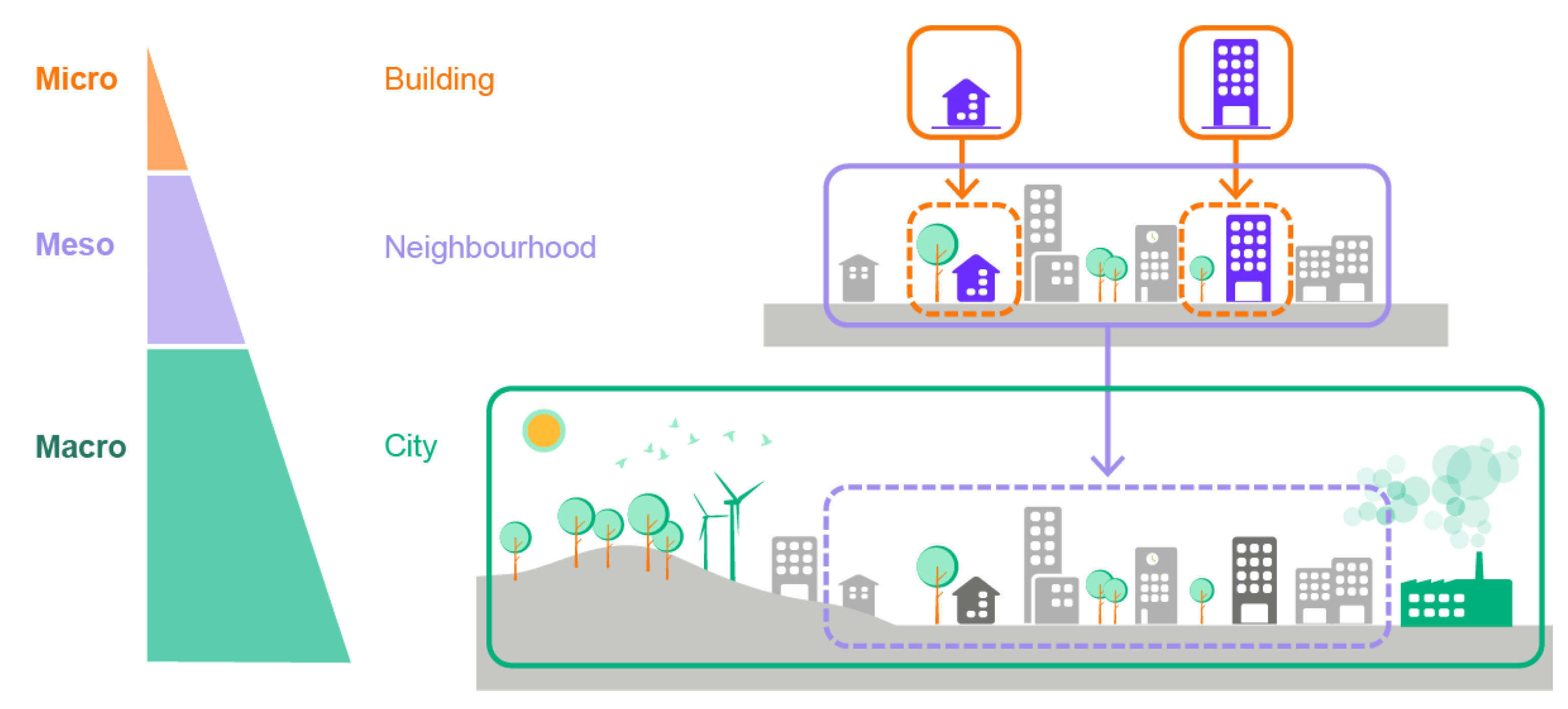
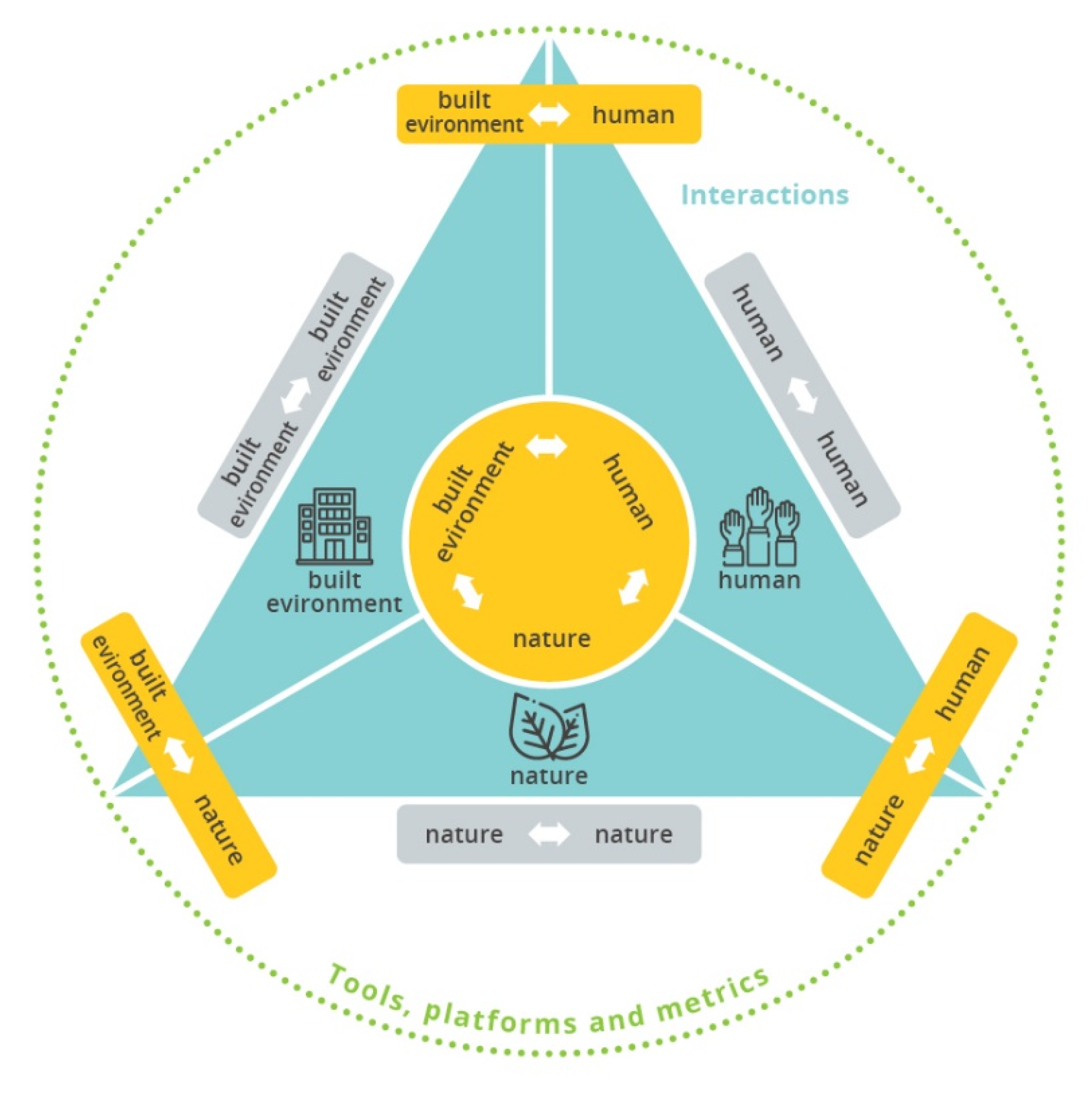
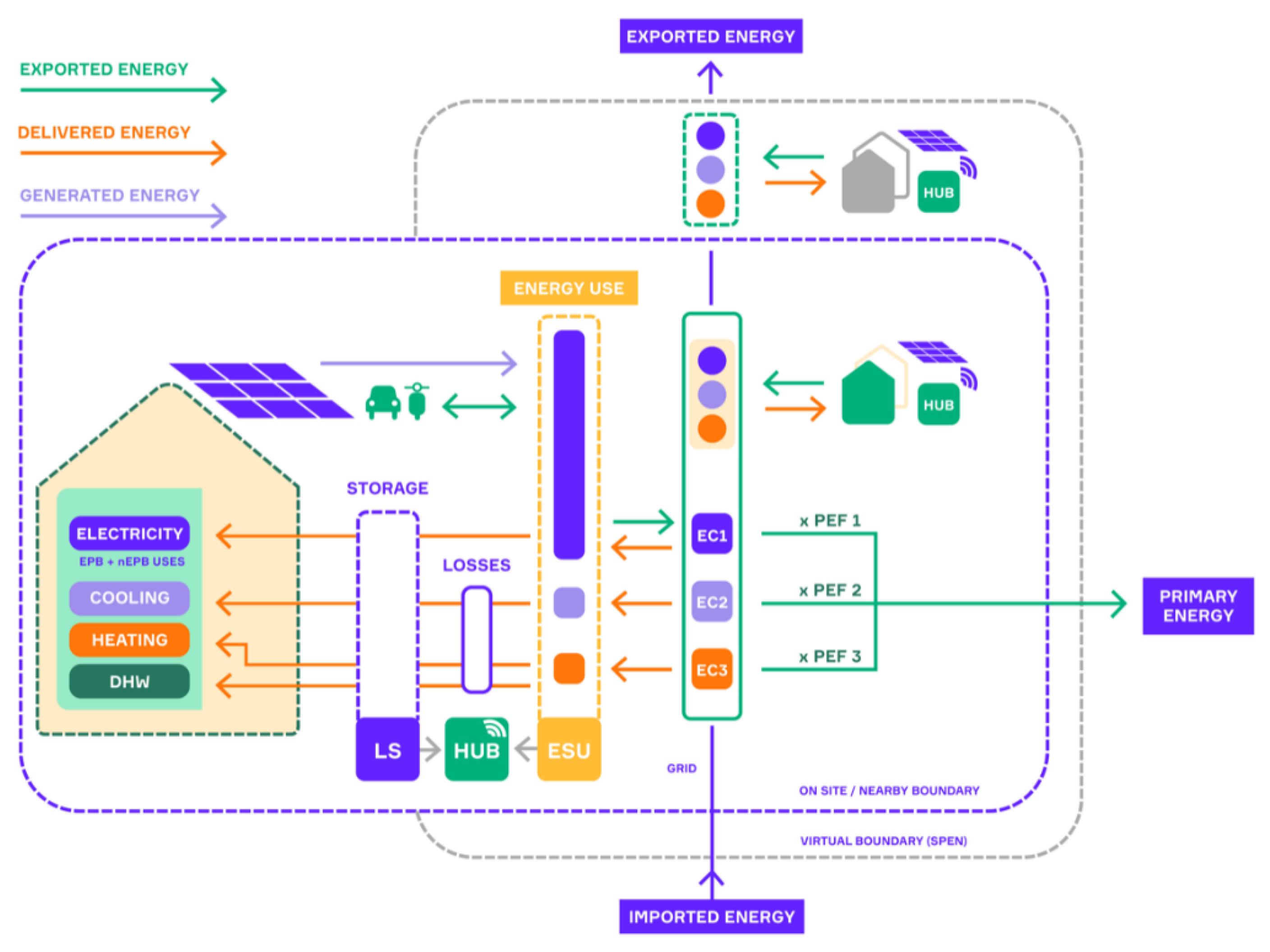




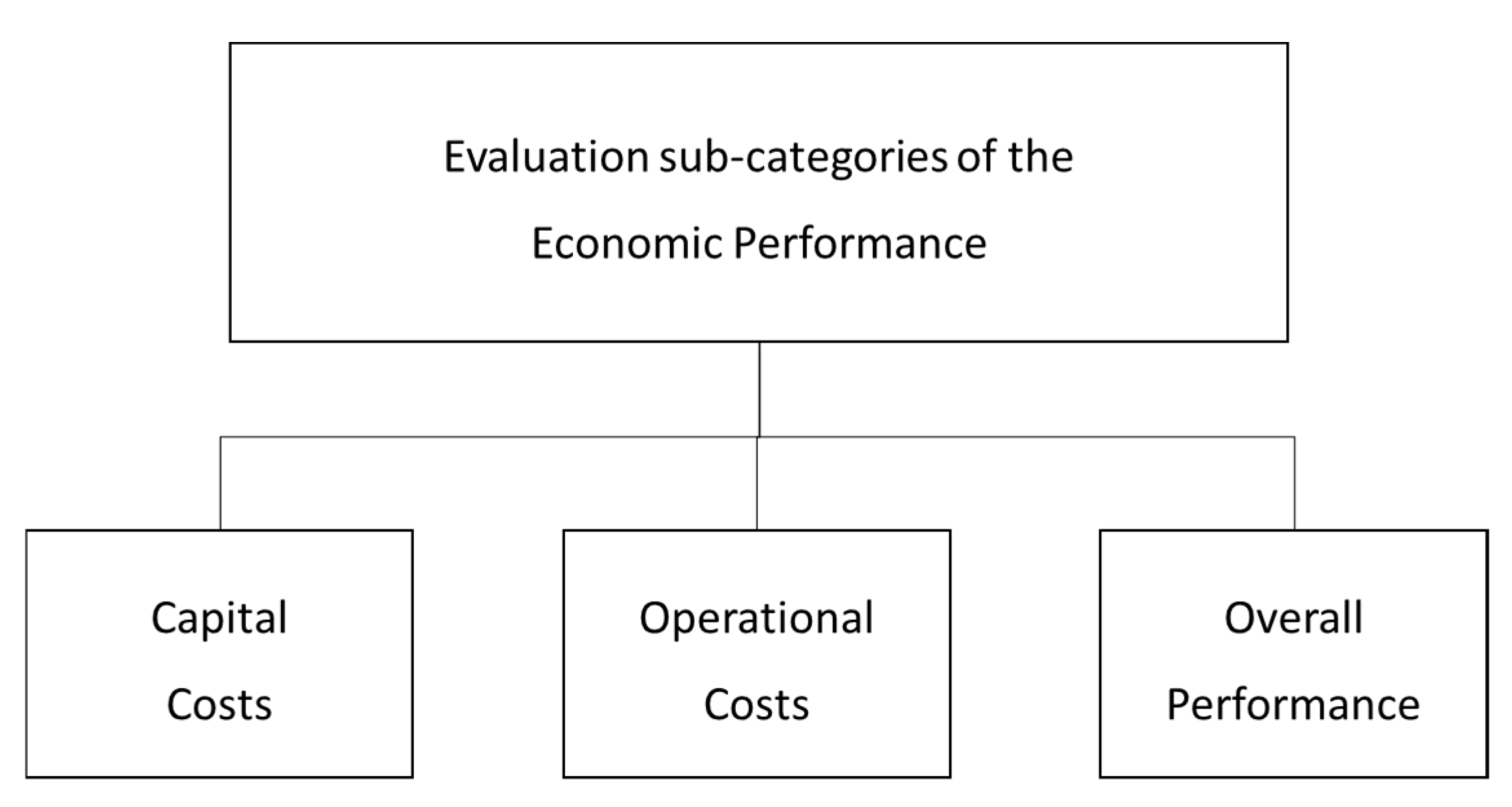
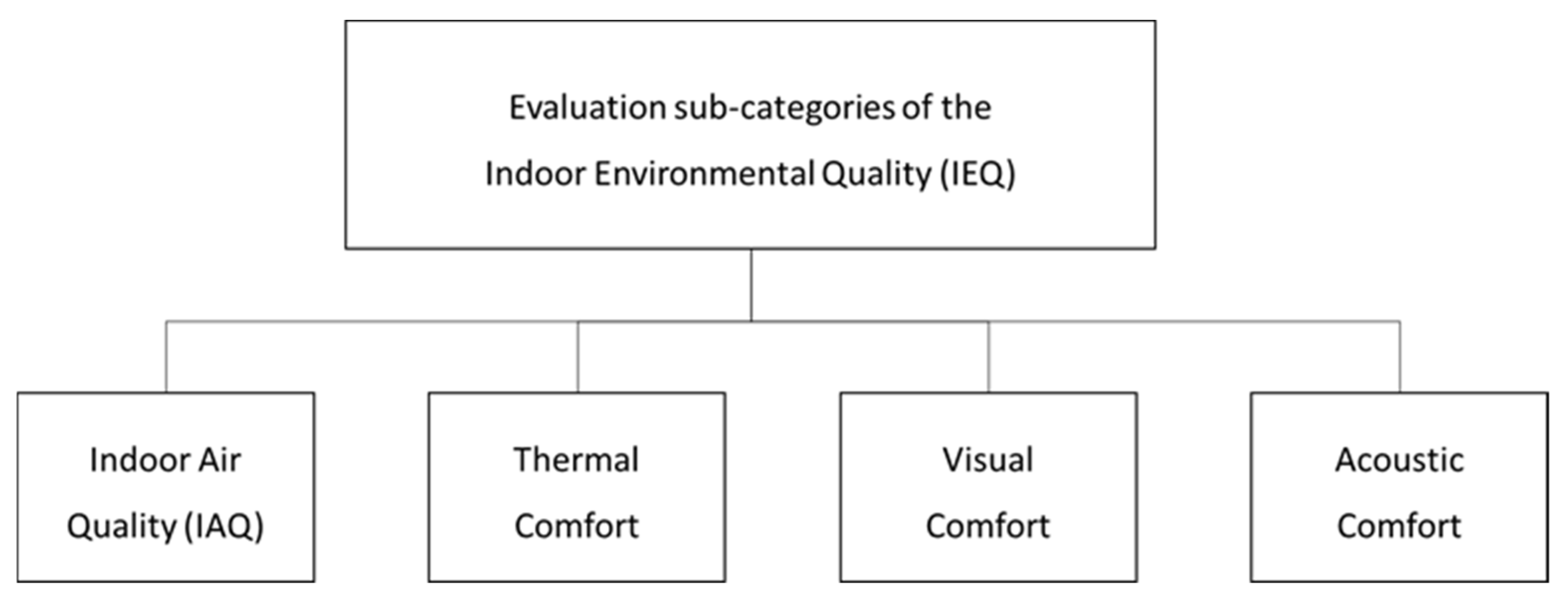
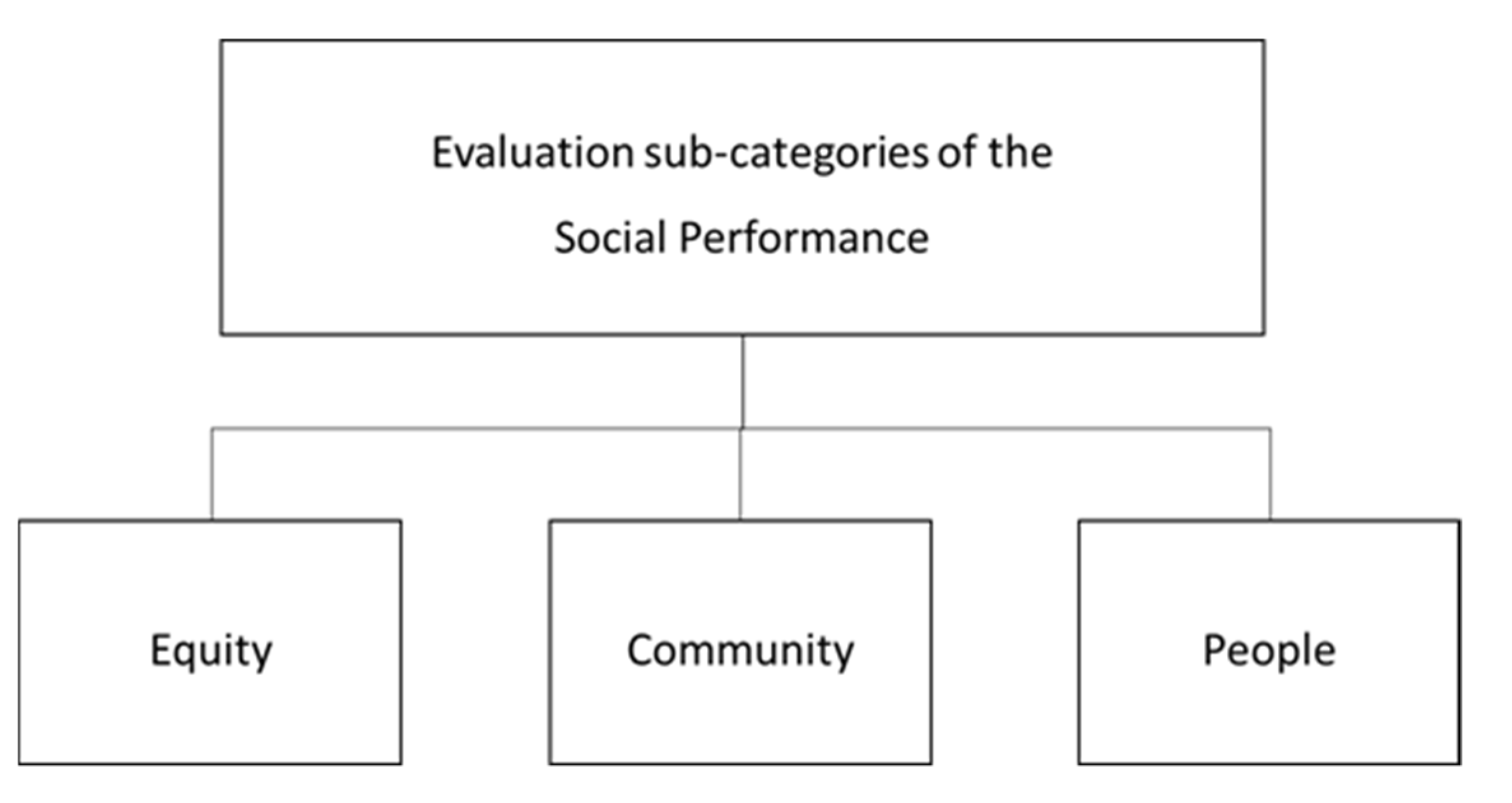
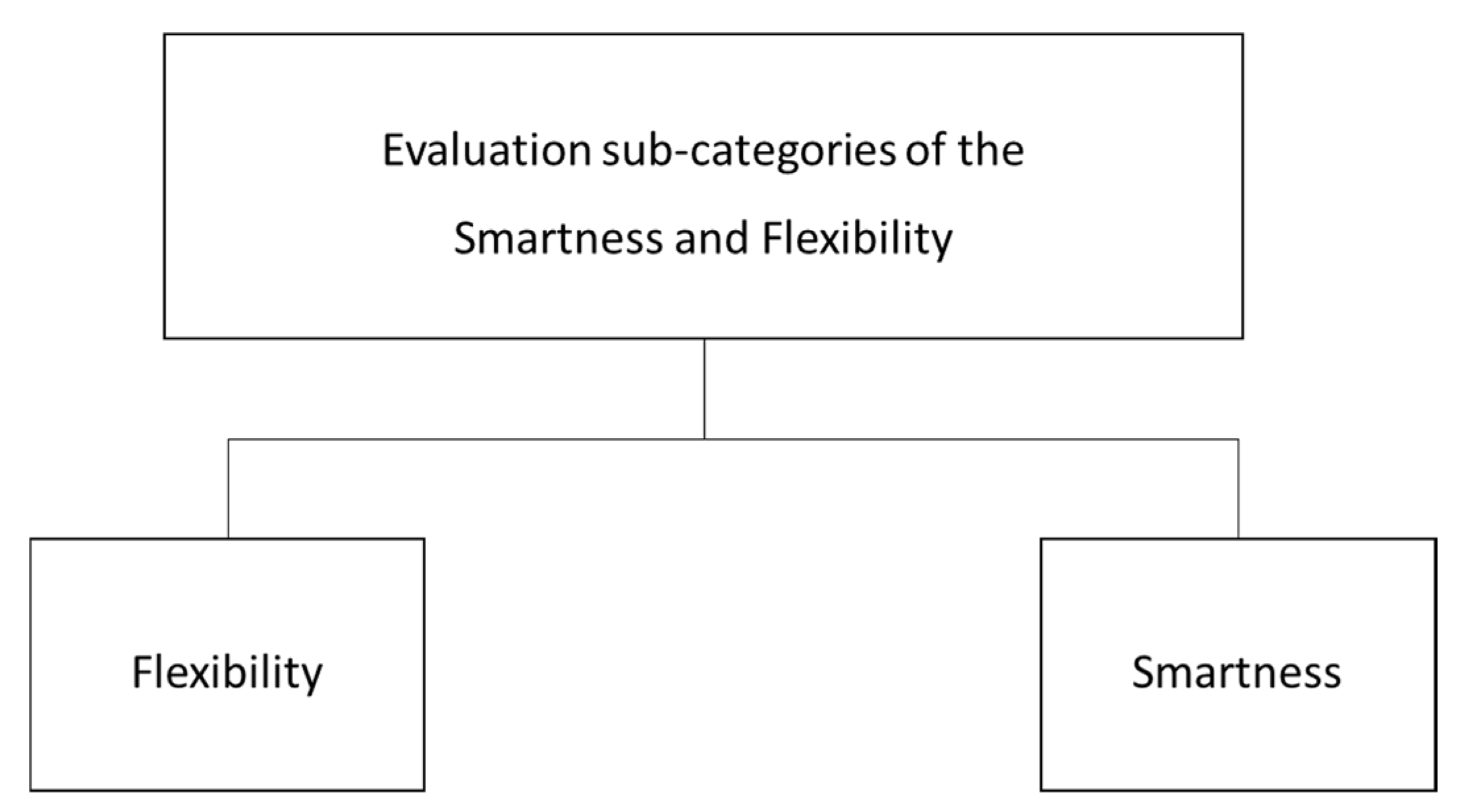
| Category | Sub-Category | Key Performance Indicator |
|---|---|---|
| Energy and Environmental Performance | Overall Performance | Non-renewable primary energy balance |
| Renewable energy ratio | ||
| Matching factor | Grid Purchase factor | |
| Load cover factor/Self-generation | ||
| Supply cover factor/Self-consumption | ||
| Grid interaction factors | Net energy/Net power | |
| Peak delivered/exported power | ||
| Connection capacity credit | ||
| Environmental balance | Total greenhouse gas emissions | |
| Economic Performance | Capital costs | Investment costs |
| Share of investments covered by grants | ||
| Operational costs | Maintenance-related costs | |
| Requirement-related costs | ||
| Operation-related costs | ||
| Other costs | ||
| Overall performance | Net Present Value | |
| Internal Rate of Return | ||
| Economic Value Added | ||
| Payback Period | ||
| nZEB Cost Comparison | ||
| Indoor Environmental Quality | Indoor Air Quality | Carbon Dioxide (CO2) |
| Thermal comfort | Predicted Mean Vote (PMV) | |
| Predicted Percentage Dissatisfied (PPD) | ||
| Temperature (T) | ||
| Relative Humidity (RH) | ||
| Visual comfort | Illuminance | |
| Daylight factor | ||
| Acoustics comfort | Sound Pressure Level | |
| Social Performance | Equity | Access to services |
| Affordability of energy | ||
| Affordability of housing | ||
| Democratic legitimacy | ||
| Living conditions | ||
| Community | Social cohesion | |
| People | Personal safety | |
| Energy consciousness | ||
| Smartness and Flexibility | Flexibility | Flexibility index |
| Smartness | Smartness Readiness Indicator (SRI) |
| Indicator Set | Shannon Index |
|---|---|
| Energy and Environment | 2.18 |
| Economic | 2.03 |
| Indoor Environmental Quality | 2.27 |
| Social | 2.23 |
| Smartness and Flexibility | 2.23 |
| Key Performance Category | 5D | 5S | SPEN Framework | DAG Handles SPEN Goals |
|---|---|---|---|---|
| Energy and Environment | Design Decarbonisation Decentralization | Save Shave Share | Self-consumption GHG emissions | Decarbonisation |
| Economic | Design | Save Scale | Cost efficiency Self-consumption | Save |
| Indoor Environmental Quality | Democracy Design | Shine | IEQ Occupant satisfaction | Design |
| Social | Decentralization Democracy | Shine Share Save Scale | Social factors Occupant satisfaction | Democracy |
| Smartness and Flexibility | Digitalization Decentralization | Shave Share | Self-consumption GHG emissions | Digitalization & Decentralization |
Publisher’s Note: MDPI stays neutral with regard to jurisdictional claims in published maps and institutional affiliations. |
© 2021 by the authors. Licensee MDPI, Basel, Switzerland. This article is an open access article distributed under the terms and conditions of the Creative Commons Attribution (CC BY) license (https://creativecommons.org/licenses/by/4.0/).
Share and Cite
Salom, J.; Tamm, M.; Andresen, I.; Cali, D.; Magyari, Á.; Bukovszki, V.; Balázs, R.; Dorizas, P.V.; Toth, Z.; Zuhaib, S.; et al. An Evaluation Framework for Sustainable Plus Energy Neighbourhoods: Moving Beyond the Traditional Building Energy Assessment. Energies 2021, 14, 4314. https://doi.org/10.3390/en14144314
Salom J, Tamm M, Andresen I, Cali D, Magyari Á, Bukovszki V, Balázs R, Dorizas PV, Toth Z, Zuhaib S, et al. An Evaluation Framework for Sustainable Plus Energy Neighbourhoods: Moving Beyond the Traditional Building Energy Assessment. Energies. 2021; 14(14):4314. https://doi.org/10.3390/en14144314
Chicago/Turabian StyleSalom, Jaume, Meril Tamm, Inger Andresen, Davide Cali, Ábel Magyari, Viktor Bukovszki, Rebeka Balázs, Paraskevi Vivian Dorizas, Zsolt Toth, Sheikh Zuhaib, and et al. 2021. "An Evaluation Framework for Sustainable Plus Energy Neighbourhoods: Moving Beyond the Traditional Building Energy Assessment" Energies 14, no. 14: 4314. https://doi.org/10.3390/en14144314
APA StyleSalom, J., Tamm, M., Andresen, I., Cali, D., Magyari, Á., Bukovszki, V., Balázs, R., Dorizas, P. V., Toth, Z., Zuhaib, S., Mafé, C., Cheng, C., Reith, A., Civiero, P., Pascual, J., & Gaitani, N. (2021). An Evaluation Framework for Sustainable Plus Energy Neighbourhoods: Moving Beyond the Traditional Building Energy Assessment. Energies, 14(14), 4314. https://doi.org/10.3390/en14144314








